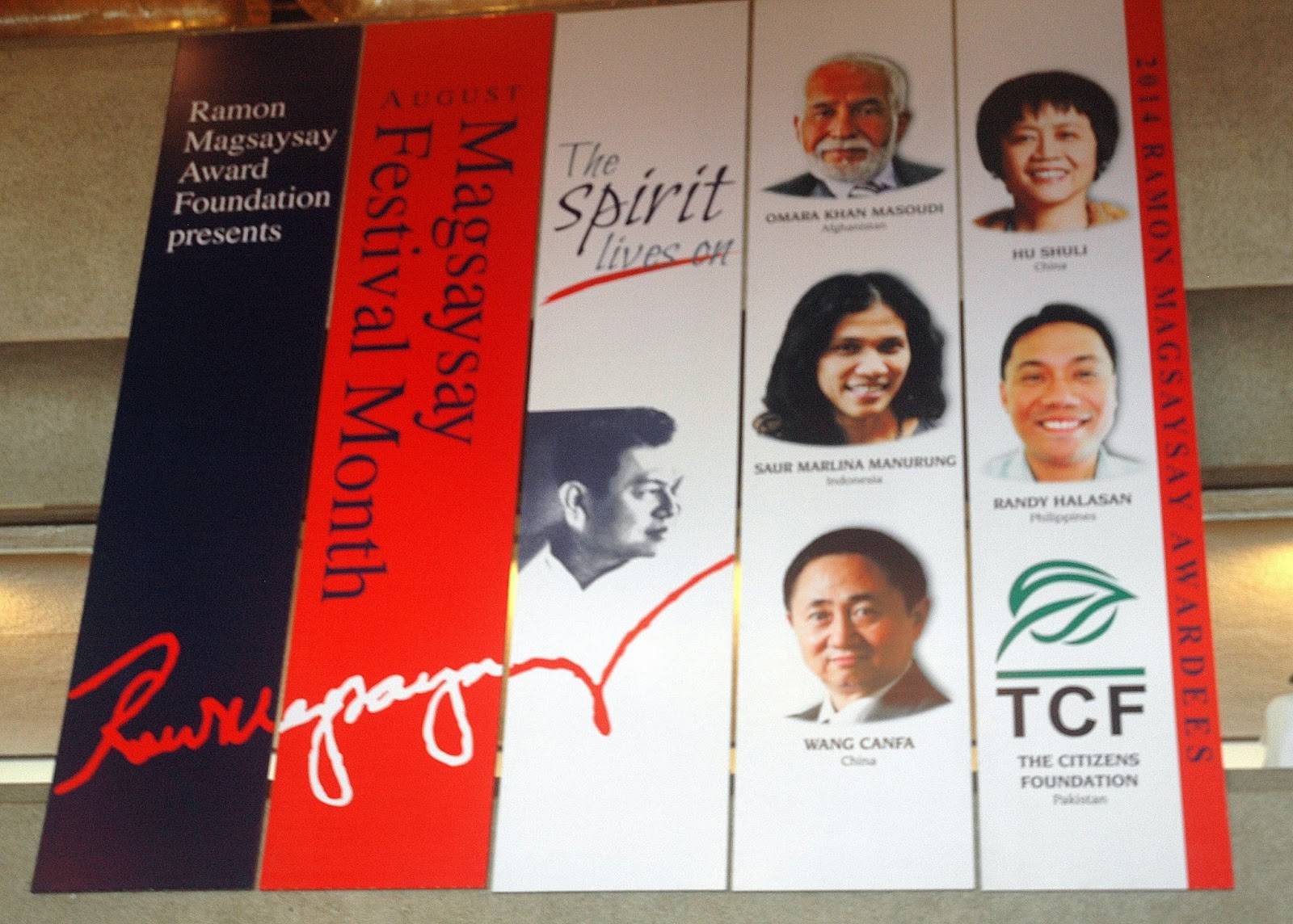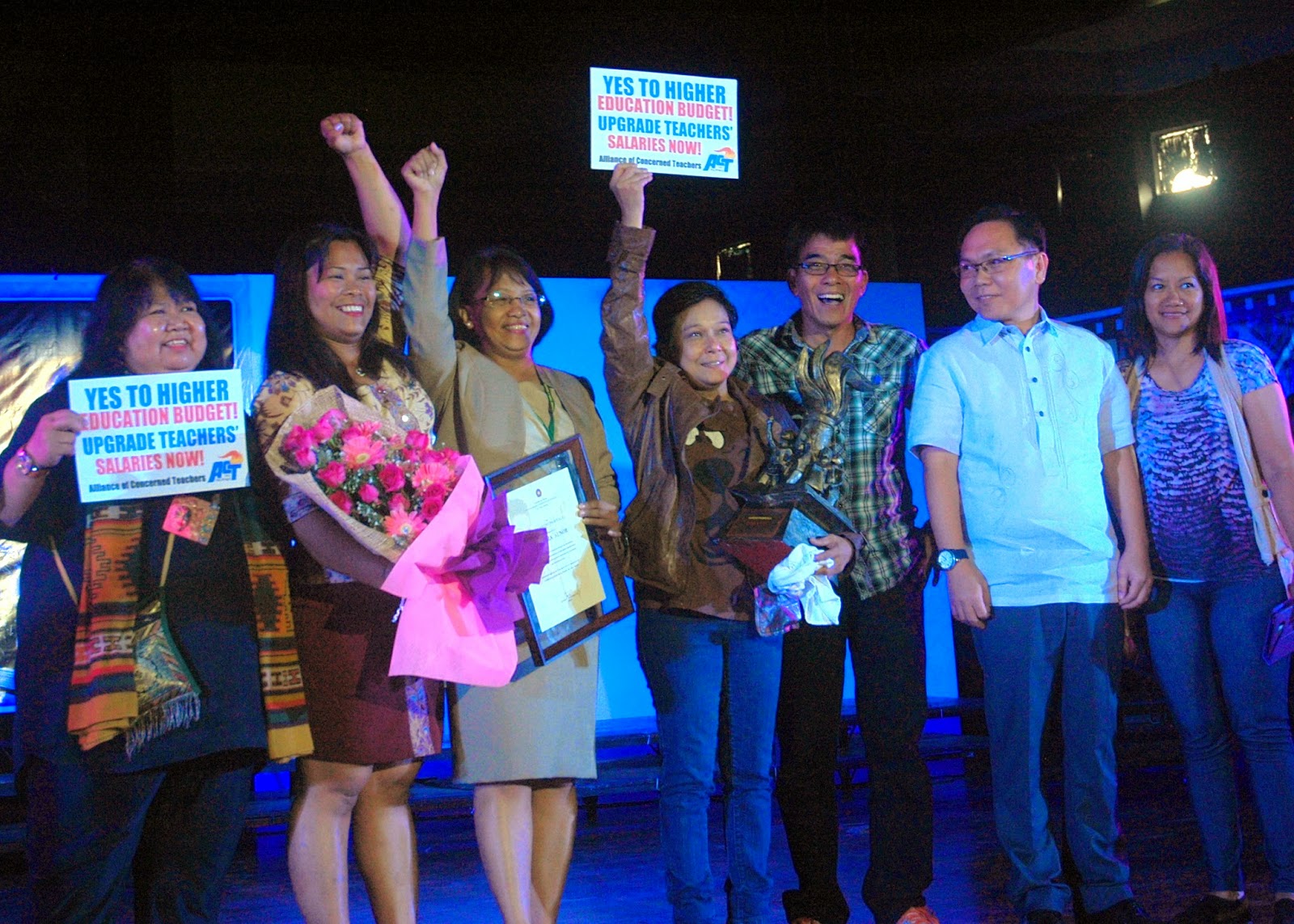Note: This photo-essay was on the filam special page of the 26 Sep-02 Oct 2014 issue of the weekly FilAm Star, 'the newspaper for Filipinos in mainstream America', published in San Francisco CA. This blogger is the Special News/Photo Correspondent in Manila of the newspaper.
The sun was out and the floodwaters that came with
Typhoon Mario were all gone on Sunday, 21 September 2014, the 42nd
anniversary of the declaration of Martial Law by Ferdinand Marcos.
 |
| The Inang Bayan at the Bantayog ng mga Bayani compound designed by the sculptor Eduardo Castrillo |
We dared to see a five-hour film in black-and-white by
Lav Diaz: “Mula sa Kung Ano ang Noon (From
What Was Before)”, which recently won the Pardo d’oro (Golden Leopard) grand prize at the 2014 Locarno Film Festival
in Switzerland. It was being screened for free as “handog sa bansa”
(gift to the nation) of the Film
development Council of the Philippines (FDCP), Sine Olivia Pilipinas and SM
Cinema. The film is said to be based on the
film maker’s memories as a young man in his village in Maguindanao before the
onset of Martial Law.
“I was just an observer,” Diaz told filmmaker Pepe Diokno
in an interview published in the Philippine Star, “but I could see it, how hell was coming in. There was so much happening
in our village. Suddenly, there were killings that we didn’t understand.
Suddenly, there were burnings of houses that we didn’t understand. We would
hear wails from the forest — scary. It turned out, it was the military. They
conditioned everything, they started everything. People would come. There would
be a carpenter, a shoe seller — they turned out to be military agents. They
started destroying the barrio. Martial Law was a well-oiled machine.”
When Martial Law
was declared toward the end of the movie, we learn that the village was
classified as part of the war zone based on the case built by a military
agent. The female sergeant was immersed
there for two years under the guise of a vendor of sleeping mats and other
household items.
After his frank
discourse with the lieutenant, the priest became the subject of surveillance. The
officer ordered one of his men to keep the priest under constant watch. The polite argument was about the military
presence there. A camp was to be built albeit
temporarily at the school yard. The officer contended it is for keeping peace,
the religious argued it would disrupt the lives of the people. True enough, families would eventually evacuate
to safer grounds.
 |
| The Wall of Remembrance bearing the names of martyrs and heroes like Ninoy Aquino and the Escalante martyrs. |
The last frames focused on two activists, purportedly from the University of the Philippines, hanging upside down and being tortured by the militia.
The movie actually
spurred us to visit the Bantayog ng mga Bayani (Monument to the Heroes)
the next day. This is neighbor to the National
Power Corporation (NPC), Transmission Company and National Grid Corporation of
the Philippines (NGCP) complex on Quezon Avenue. We only passed by the Bantayog during all the
years we worked in NPC. Our first
purposeful visit was in November 2011 when a fraternity brother’s name was
inscribed as a martyr-hero on the Wall of Remembrance.
The Bantayog is the memorial center honoring men and
women who lived and died in opposition to the repressive regime under the
Marcos dictatorship for fourteen years, 1972 to 1986. The landmark is a 14-meter Inang Bayan (Mother Philippines) Monument designed
by the sculptor Eduardo Castrillo. It
depicts a fallen man, held in one hand by a woman symbolizing the Motherland
while the other hand reaches out for freedom.
The other distinct feature is the Wall of Remembrance of
black granite, where the names of martyrs are inscribed. The first sixty-five martyrs were enshrined here in 1992, which include Ninoy
Aquino. Today there are now more than two hundred names of heroes inscribed comprising
“those who gave their all for the sake of freedom, justice, and democracy
during the Marcos years but died after the EDSA Revolution.”
 |
| Exhibit: Popular Bayan Ko and photo-cutout of Sen. Jose Diokno |
The Bantayog
Museum has several sections. One portrays “the economic, political and social
problems of the 1960s (mass poverty, abusive government officials, violation of
civil liberties) that gave rise to popular discontent especially of the youth”
during the pre-martial law years.
The death of
democracy is shown by the documentation on the methods of torture, and the
model of a prison cell done by an ex-detainee.
The memorabilia from the period of resistance include underground
publications, the “mosquito press,” reports from the various civil-society
groups at that time, and expressions of international solidarity.
Museum visitors
will also find reminders of the assassination of Ninoy Aquino and the nationwide
protests that ensued. The scale model of
a military tank surrounded by a photographic mural of the people on EDSA brings
to mind the “People Power Revolution” of February 1986.
We gave some time
to read the exhibit of a pastoral letter dated 11 August 1973 by four Catholic
bishops of Western Visayas led by then Archbishop Jaime Sin of Jaro who were “deeply
disturbed by recent events [in July] in the local Church of Antique ... One priest was taken prisoner and one
church building was declared off limits to the people. Many priests are warned
to limit their pastoral work, and rumors circulated discrediting all. It has
all the appearance of harassment.”
 |
| EDSA 1 reminder. |
A Hall of
Remembrance features the capsule biographies and individual photos of the
enshrined martyrs and heroes. These can also be accessed through the website of
the Bantayog.
 |
| Remembering the departed with candles and roses. |
“... let us not
forget those who fell during the night. Let us honor the Filipino patriots who
struggled valiantly against the unjust and repressive rule of Ferdinand Marcos.
Let us build a memorial to those men and women who offered their lives so that
we may all see the dawn... For as we remember those victims of authoritarian
rule, we shall become more vigilant about preserving our freedom, defending our
rights, and opposing any attempt by anyone to foist another dictatorship upon
us. ... In honoring our martyrs, we proclaim our determination to be free
forever.” This is the rationale of the
Bantayog in its final concept paper..
 |
| The Oct 1971 Phil. Free Press editorial opposing extension of presidential term beyond 1973, and
the Sept 1972 issue of the only newspaper allowed to operate after the declaration of Martial Law.
|
Thus, “Never again to Martial Law, Never again to Dictatorship!” is a timely call as the media is abuzz with loud talks of ChaCha (sharter change), term extension of Benigno Aquino III, and clipping the powers of the judiciary.



















